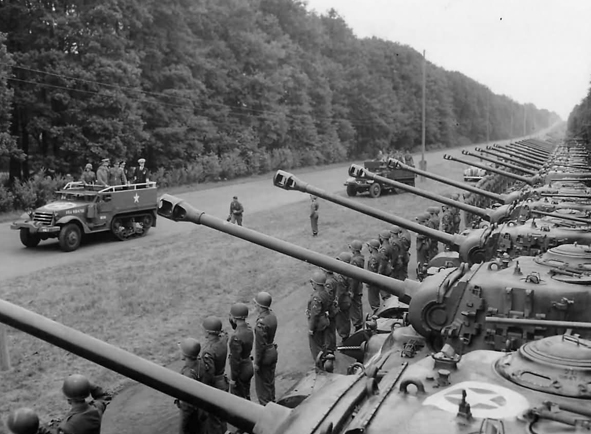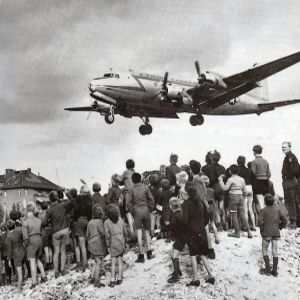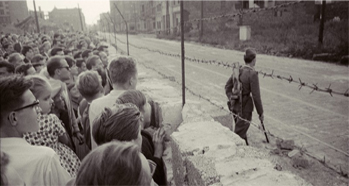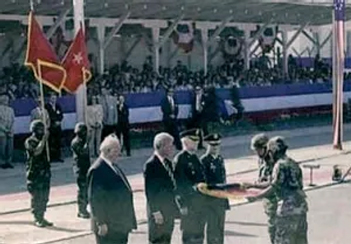The first contingent of approximately 175 U.S. Army troops, led by Colonel Frank Howley, a Civil Affairs officer specializing in military government, entered the Berlin area (Babelsberg, near
Potsdam) on July 1, 1945. Their defined mission was to assess and occupy the sector expected to be assigned to the U.S. in the aftermath of the war. Colonel Howley’s book, Berlin Command, well documents his experience within the city and his personal and professional relationships with his contemporaries during those turbulent four years in the immediate aftermath of the war.
The city lay in ruins from the incessant Allied bombing campaigns and the brutal house-to-house fighting between the Soviets and the last-ditch German defenders, which left very little in the form of public services. Howley’s contingent set to work upon arrival in coalition with their Allied partners – the British, French, and Soviets, all of whom operated under the Allied Kommandatura arrangement agreed upon in earlier conferences, to bring order from chaos.


The first major U.S. combat unit arriving in Berlin in the first week of July 1945 was the 2nd Armored Division. In little more than a month, the 82nd Airborne Division replaced the 2nd Armored Division, then in December, the 78th Infantry Division replaced the 82nd Airborne Division. U.S. Army Air Corps units also took over Tempelhof Airfield in the same general time frame, with the 862d Engineer Aviation Battalion building a concrete runway where there had previously only been sod.
The Potsdam Conference that defined the final accords between the Allies began in mid-July 1945 and lasted until early August. These activities further explained occupation of Germany and Austria, shifted the eastern border of Germany, effectively reducing her geographical footprint by 25%, and outlined the terms of surrender for Japan, who continued to fight while the conference progressed. Leadership at the conference, occurring only five months after the Yalta Conference, also changed with President Truman and Prime Minister Attlee replacing FDR (who had passed in April) and Churchill (who had lost his reelection campaign), respectively.
The months were turbulent following the cessation of hostilities in World War II in Europe, and nowhere more so than in Berlin. The western Allies frequently found themselves at odds with the Soviet Union and it became quickly apparent that the wartime alliance was a thing of the past. The occupation arrangement led to increasing levels of difficulty in both military and diplomatic settings, especially between the U.S. and the Soviet Union.
In 1946 the Berlin garrison force was organized as the Provisional Constabulary Squadron and was augmented by one infantry battalion of the 78th Division, an MP battalion, and service troops. In November 1946, the garrison was again reorganized into the 16th Constabulary Squadron, the 759th MP Battalion and the 3d Battalion, 16th Infantry Regiment, plus service troops. With the formation of the U.S. Air Force in 1947, Tempelhof became a USAF base in the city.

During the Berlin Airlift beginning in 1948, the organization remained basically the same, augmented by such units as were needed to assist in airlift operations, both Army and Air Force. In 1949, the Berlin Army garrison came under the overall command of US Army Europe. In October 1950, the garrison again reorganized and became the 1st, 2d and 3d battalions of the 6th U.S. Infantry Regiment, an association with Berlin that lasted until 1984.
As the Cold War intensified in the late 1950s and 1960s, access problems to the city, both land and air, continued to cause tension. USAF aircraft were harassed as they flew in and out of the city and ground convoys were disrupted en route to and from Berlin. In June 1958, Company F, 40th Armor Regiment came into the city with three platoons of M26 Pershing tanks. On 1 December 1961, in direct response to the construction of the Berlin Wall in August and the standoff at Checkpoint Charlie in October, the Berlin garrison was again reorganized—this time into the U.S. Army Berlin Brigade. From 1961 through January 1966, battle groups and then battalions, after the Army ceased the battle group concept, rotated into the city every ninety days. Operation LONG THRUST, directed by President Kennedy in the aftermath of the August and October 1961 crises, intended to demonstrate American resolve in remaining within West Berlin.
In September 1963, Battery C, 94th Artillery deployed into the city as part of the Berlin Brigade, the only artillery the Western Allies had in the city, and engineer units working in the city were organized into the 42d Engineer Company in the mid-1960s.
USAF units continued to support the city from Tempelhof Central Airport (TCA) throughout the period. Between 1946 and 1964 Soviet aircraft attacked twelve U.S. aircraft, causing the death of thirty-six crew and passengers. Pilots and aircraft were continually harassed as they flew in and out of Berlin. Flying in and out of Berlin was inherently dangerous. Through it all, the Berlin Air Traffic Control Center kept aircraft flying safely through all weather and conditions, including the incredible and memorable achievement of the Berlin Airlift (1948-49).
In 1984, the three battalions of the 6th Infantry Regiment were re-designated as the 4th, 5th and 6th battalions, 502d Infantry Regiment. In September 1990, 6th Battalion, 40th Armor became the command and control headquarters for the two tank companies, the artillery battery and the engineer company.
The Cold War came to the beginning of the end when the Berlin Wall opened in November 1989. Due to the dedication of the soldiers and airmen of the Berlin Command since 1945, the blight of the Berlin Wall was no more. So too spelled the end of the mission of the Berlin Command. To that end, the 7350th Air Base Group inactivated at TCA on 29 January 1993. On 12 July 1994 the Berlin Brigade furled its colors for the last time in a ceremony at the Four Ring at McNair Barracks. The Cold War was over. We could proudly say that we had done our part. Berlin remains free!
The “crisis” in Berlin abated, but the tensions remained through the years, easing somewhat after the Quadripartite Agreements of 1971. This historic agreement broke ground in the Soviets acknowledging the right of the Western Allies to be in Berlin. Harassment eased to a level, but Berlin Command troops remained on a high state of alert. The murder of Major Arthur Nicholson, shot by a Soviet sentry and allowed to bleed to death in 1985, is stark testimony to the fact.

